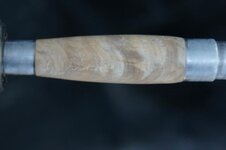Jim Campbell
Member
I have been challenged with an ongoing issue when turning burl pens. It's the pitting/pockets. I've read various blogs and it seems inevitable to have pitting in burls pens.
What ideas are out there to either prevent the pitting, or ways to fill the pits and finish the pen.
I apologize for the less than favorable photo, but hopefully you can see what it is I'm describing. The pen is currently sanded to 220.
What ideas are out there to either prevent the pitting, or ways to fill the pits and finish the pen.
I apologize for the less than favorable photo, but hopefully you can see what it is I'm describing. The pen is currently sanded to 220.

